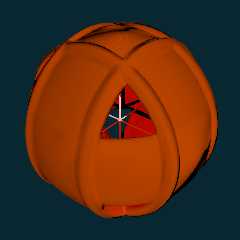|
 |
<---------------------- References. Nine previous posts
http://news.povray.org/povray.beta-test.binaries/thread/%3C5eb4b9c6%241%40news.povray.org%3E/
and
http://news.povray.org/povray.beta-test.binaries/thread/%3C5ebe9706%241%40news.povray.org%3E/
Adding the function f_morph2to9fncts() to be able to set up complex
morph-able shapes. In the attached image, set up 9 torus shapes and then
started twiddling. Shapes just sort of happen unless you plan ahead for
some specific morph-able thing.
#declare VrR = 0.05;
#declare Fn00 = function (x,y,z) {
f_morph2to9fncts(9,-VrR,+VrR/9,
f_torus(y+0.0,x+0.2,z+0.0,0.5,VrR),
f_torus(y+0.0,x/5-0.0,z,0.5,VrR),
f_torus(y-0.0,x-0.2,z-0.0,0.5,VrR),
f_torus(x+0.2,y+0.0,z+0.0,0.5,VrR),
f_torus(x+0.0,y/5-0.0,z,0.5,VrR),
f_torus(x-0.2,y-0.0,z-0.0,0.5,VrR),
f_torus(x+0.0,z+0.2,y+0.0,0.5,VrR),
f_torus(x+0.0,z/5+0.0,y,0.5,VrR),
f_torus(x-0.0,z-0.2,y-0.0,0.5,VrR),
1/9,2/9,1/9,
0/9,1/9,0/9,
1/9,2/9,1/9
)
}
#declare Persimmon = srgb <0.92549,0.3451,0>;
#declare Iso99 = isosurface {
function { Fn00(x,y,z) }
...
A whole bunch of knobs / parameters.
---- f_morph2to9fncts
Parameters:
1. Count of value inputs from 2 to 9.
2. Clamp on how negative any given function contribution can be.
3. Clamp on how positive any given function contribution can be. This
one more important than (2) because letting any given function's
positive, outside the shape, values get too large really limits what can
be accomplished with respect to morphing. In fact, internal to
f_morph2to9fncts(), the value specified is modified to be
value/non-zero-weights. In other words, it's normalized at start.
4-12. Input values (function calls) as parameters.
13-21. Weights as portion of the sum of all weights.
Notes. Sums and averages input values according to the weights. Can
morph in place or along a gradient. The math to control the morphing -
set the weights - done outside this function. The weights themselves can
be set up as 1/function-count or similar. Internally, they get totaled
and the particular functions contribution is its weight against the total.
A good starting place with the negative and positive clamp values is -1
and 1 unless you know the max negative values with the torus minor
radius for example in which case start with +- that value. If too many
shapes, or too much of some shapes are disappearing lower the positive
clamp some more. You can of course set the clamps to large values to
avoid clamping altogether - most used when morphing from one shape to
another.
----
In other news; added some other lessor helper functions and pattern
implementations.
f_cbrt(), f_hypot(), f_onion(), f_sign(), f_sign0(), f_signpow()
and f_signsqrt().
Lastly, The isosurface in the image is intentionally implemented with a
large accuracy, and with the new jitter on, for effect. You can get some
interesting shapes this way (sometimes by accident...).
Bill P.
Post a reply to this message
Attachments:
Download 'morphstory.png' (326 KB)
Preview of image 'morphstory.png'

|
 |




![]()